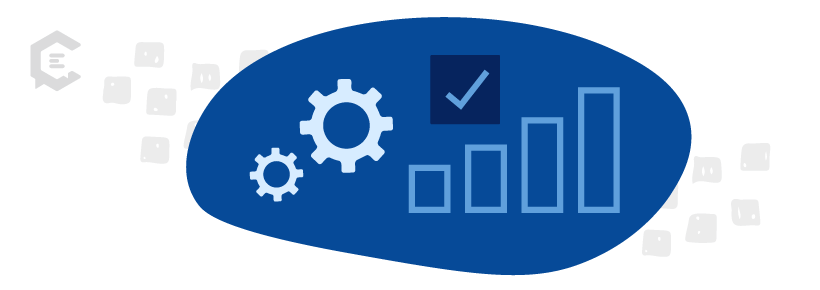We often talk about why content marketing matters and the ROI of content marketing… well, here it is, friends. The best way to rank on Google is through high-quality content marketing.
Like it or not, what Google wants definitely matters
Ever since the beginning of Google Search in 1997, the worldwide market share of all search engines has belonged to Google. Bing and Yahoo get a teeny-tiny percentage of the search engine market share, while Google dominates.
As of June 2022, the search engine market share breakdown for each platform is:
- Yahoo = 2.55%
- Bing = 8.88%
- Google = 83.84%
This means that what Google wants matters more than ever before to any organization with a digital footprint — which is every business today since every business (B2B and B2C) must have a digital presence to exist.
The good news is that Google’s mission aligns with every content marketer’s purpose — to create high-quality content that helps people find solutions. What Google wants also goes hand-in-hand with what your customers want. Rather than thinking, we’re all here to please the Google overlords, we’re still talking about serving our audience in the best way possible.
There’s no denying that search positioning impacts business success. A higher position on the page means:
- Your business is more likely to be found by potential customers.
- Your website traffic increases, which brings more brand awareness and interest.
- Your content engages visitors, which eventually turns leads into sales opportunities.
Google has an insane amount of ranking factors that affect the search ranking position of your website, and the algorithm is famous for changing moods on a whim. Knowing where to focus your attention seems impossible when you’re dealing with Google’s complexities and mood swings. But you can hedge your bets on content marketing to help you rank on Google.
Google says content marketing is the No. 1 ranking factor
Google’s SEO Starter Guide is a beast, with pages upon pages of detailed information. Rather than putting you to sleep with too many SEO best practices, let’s extract the section that alludes to content marketing being the best way to rank on Google.
“Creating compelling and useful content will likely influence your website more than any of the other factors discussed here. Users know good content when they see it and will likely want to direct other users to it. This could be through blog posts, social media services, email, forums, or other means.”
Google loves to keep its algorithm a mystery, which is why you won’t see Google stand too firmly behind ranking factors. This is as close as you’re going to get with the rather wishy-washy statement that content will “likely” influence your website more than any other factors discussed in the SEO Starter Guide.
But we’ll take it. Because we know that content marketing (done right) works, and it does affect everything from website performance to Google page positioning. When you do content marketing right, people take notice, begin to trust your brand, and over time, they turn your direction when they are considering purchasing a solution.
Just doing content is not the same as doing it well. Google gets this — after all, their entire business model relies on serving up relevant information to people who are searching for answers. Google doesn’t want to see self-serving content, it wants to see content that serves others.
What does creating compelling and useful content mean?
A good rule of thumb for “doing content well” is following Google’s advice and focusing your efforts on “creating compelling and useful content.” That’s a pretty vague/overused phrase, so let’s workshop it.
A formula for creating compelling and useful content that’ll rank on Google is as follows:
- Know your audience. If you want to rank No. 1, you need to follow content marketing rule No. 1 (no matter how tired you are of hearing it). Use a buyer persona template to help you get started.
- Be human. Content is really just a conversation. You need to sound like your brand, but you also need to sound like a human if you want to relate to people. When creating your brand voice guide, you’ll want to also consider your brand’s mission and voice.
- Align content with the journey. Top-of-funnel content builds awareness and trust, middle-of-funnel content supports research and evaluation, and bottom-of-funnel content validates the decision and purchase.
- Collaborate to uncover great topics. Blog topic discovery should never happen in silos. The best content for your audience will only happen when more voices and minds from your organization join in the content creation process.
- Create CTAs people actually click. The call-to-action is very often a “learn more” afterthought… we can do better! Make your CTAs more clickable and customized by including data, testimonials, aspirations, challenges, or solutions.
- Use content to build customer loyalty. Content isn’t just about serving potential customers, it’s also about supporting our existing customers. Even though organizations know they should create this content, it rarely happens.
How to rank on Google
We all want to see our website and content at the top of the search engine results page (SERP).
Content marketing is a fine place to focus your energy, but your overall search ranking success depends on an orchestrated effort that involves several other ranking factors. But there are so many… how do we know which factors to prioritize?
Search Engine Journal (SEJ) evaluated 88+ ranking factors and narrowed this long list down to eight of their selections for top ranking factors for Google, which are:
- High-quality content
- Mobile-first
- Page experience
- Page speed
- On-page optimization
- Internal links
- External links
- Local
Even though SEJ stated that these ranking factors were in no particular order, you’ll notice high-quality content just so happens to be at the very top of the list. If we turn back to Google’s SEO Starter Guide, Google had this to say about optimizing content:
“Organic or word-of-mouth buzz is what helps build your site’s reputation with both users and Google, and it rarely comes without quality content.”
To rank on Google (hopefully high up on the first page), you’ll find that SEJ’s list of eight top-ranking factors is solid guidance. Work your way through this list, and simultaneously, keep iterating and improving to ensure you get that quality content gold star from Google.
Content marketers, this is a time to rejoice. This Google ranking factor announcement not only brings job security but also supports the cause you’ve been fighting for all along. You always knew that content mattered and that content ROI was tangible.
Google has your back. Now it’s up to you to exceed Google’s expectations by creating compelling and useful content. Which you should be doing anyway to support your existing and potential customers.
Keep going, and keep doing what you do best.
Need help creating content that will rank highly on Google and convert your target audience? Talk to a content specialist today to get started.





